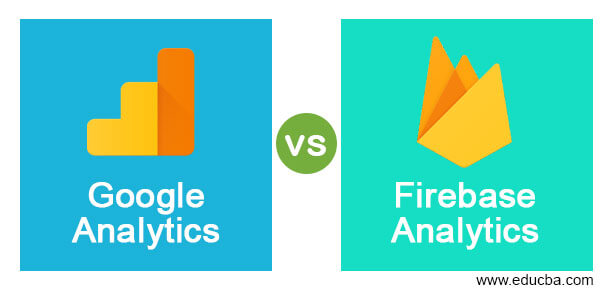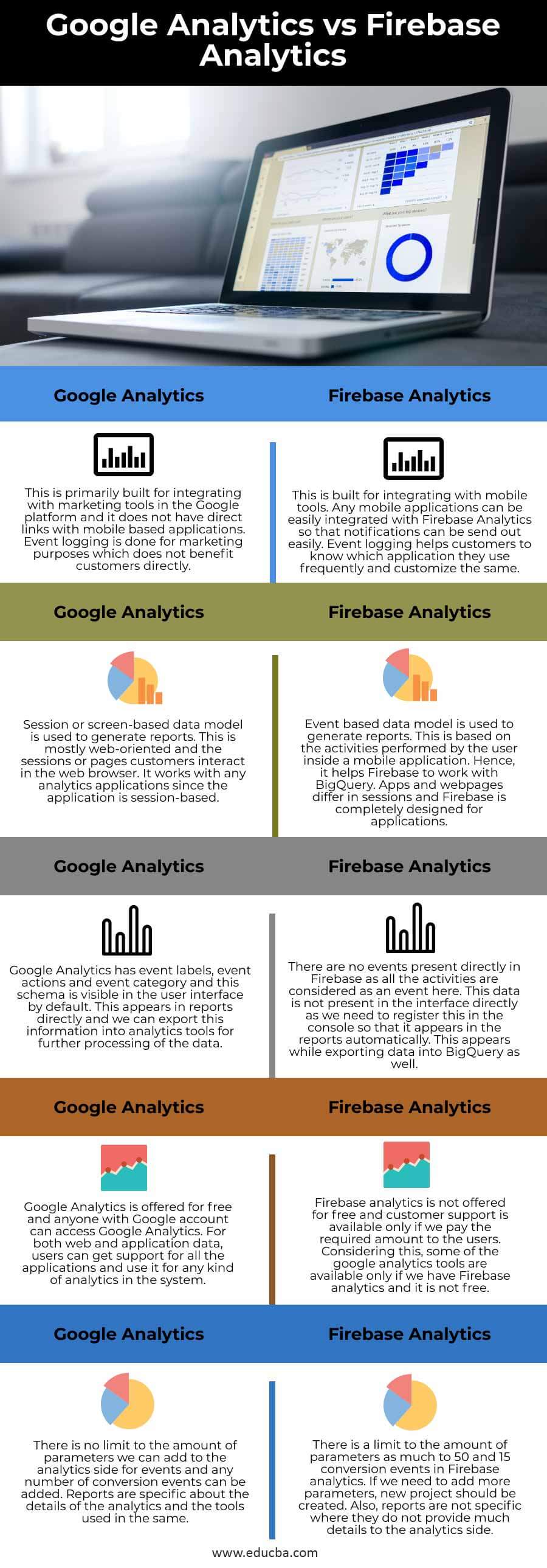
Difference between Google Analytics vs Firebase Analytics
The following article provides an outline for Google Analytics vs Firebase Analytics. A web analytics service provided by Google where website traffic is tracked and reported by making the JavaScript to run in web pages so that it helps in statistical tools for marketing purposes is called Google Analytics. Any amount of data can be accessed that helps to know how users are interacting with different websites. An analytics engine provided by google to know the customer behaviour with Android and iOS applications is called Firebase analytics. All the events are captured and notable events required by the user is taken into consideration so that changes can be made easily.
Head to Head Comparison Between Google Analytics vs Firebase Analytics (Infographics)
Below are the top 5 differences between Google Analytics vs Firebase Analytics:
Key Difference Between Google Analytics vs Firebase Analytics
Let us discuss some of the major key differences between Google Analytics vs Firebase Analytics:
- If we need to send the page to analytics for any use cases, we should incorporate a JavaScript code into the web page so that it will be sent to Google Analytics. Mobile analytics can also be done in Google analytics where screenshots or activities are sent to Google Analytics. Firebase was initially created to manage applications in iOS and Android. Firebase Analytics was introduced later to manage the analytic works of all the applications in iOS and Android.
- Consider we are using both iOS and Android applications in both Firebase and Google Analytics. Data is considered at the project level in Firebase and hence entire data is into one dataset. If we need to access any data belonging to iOS or Android, we can use the project directly. Overall metrics can be viewed at the project level in the system through Firebase Analytics. Using Google Analytics, we must set a property for both iOS and Android applications to send it via application mode or we can send it through the web browser without setting any property to the applications. Hence, interface flexibility is more in Google Analytics than in Firebase Analytics.
- Both Google Analytics and Firebase Analytics offers support in almost all the platforms. Any applications that can be configured in iOS and Android applications can be configured with Firebase as well. This includes any OTT platforms or any messaging applications. If the application is not supported in Android or iOS, it is difficult to get the analytics details from the application using Firebase. Google Analytics is a master here that it can be used for any applications regarding iOS and Android. Also, the web browser is another option to get connected with all applications.
- Search-Engine-Optimization, pay-per-click and content making is the form of marketing techniques used in Google Analytics. Any data regarding customers can be noticed and necessary changes in the web pages can be made so that marketing can be done in the web pages or applications directly without much of customer recognition. This helps in increasing the sales of any particular item. Events, user properties, conversions and audience are the major properties used in Firebase analytics to manage the application and make it customized for user needs. Better applications can be created based on this which eventually will produce better results in the analytics tools. This data collection helps to monitor the customers and then develop applications completely based on their needs.
Google Analytics vs Firebase Analytics Comparison Table
Let’s discuss the top comparison between Google Analytics vs Firebase Analytics:
| Google Analytics |
Firebase Analytics |
| This is primarily built for integrating with marketing tools in the Google platform and it does not have direct links with mobile-based applications. Event logging is done for marketing purposes which do not benefit customers directly. | This is built for integrating with mobile tools. Any mobile application can be easily integrated with Firebase Analytics so that notifications can be sent out easily. Event logging helps customers to know which application they use frequently and customize the same. |
| A session or screen-based data model is used to generate reports. This is mostly web-oriented and the sessions or pages customers interact with in the web browser. It works with any analytics application since the application is session-based. | Event-based data model is used to generate reports. This is based on the activities performed by the user inside a mobile application. Hence, it helps Firebase to work with BigQuery. Apps and webpages differ in sessions and Firebase is completely designed for applications. |
| Google Analytics has event labels, event actions and event category and this schema is visible in the user interface by default. This appears in reports directly and we can export this information into analytics tools for further processing of the data. | There are no events present directly in Firebase as all the activities are considered as an event here. This data is not present in the interface directly as we need to register this in the console so that it appears in the reports automatically. This appears while exporting data into BigQuery as well. |
| Google Analytics is offered for free and anyone with a Google account can access Google Analytics. For both web and application data, users can get support for all the applications and use it for any kind of analytics in the system. | Firebase Analytics is not offered for free and customer support is available only if we pay the required amount to the users. Considering this, some of the google analytics tools are available only if we have Firebase analytics and it is not free. |
| There is no limit to the number of parameters we can add to the analytics side for events and any number of conversion events can be added. Reports are specific about the details of the analytics and the tools used in the same. | There is a limit to the number of parameters as much to 50 and 15 conversion events in Firebase analytics. If we need to add more parameters, a new project should be created. Also, reports are not specific where they do not provide many details to the analytics side. |
Conclusion
There are advantages in both analytics tools and hence we can make use of both tools simultaneously. We can install both Firebase and Google Analytics in the system so that some reports can be created in Google analytics. If the analytics is purely application-based, we can move on with Firebase.
Recommended Articles
This is a guide to Google Analytics vs Firebase Analytics. Here we discuss key differences with infographics and comparison table respectively. You may also have a look at the following articles to learn more –

